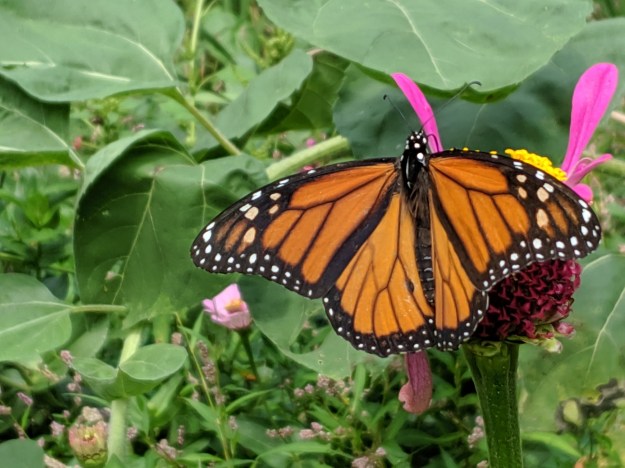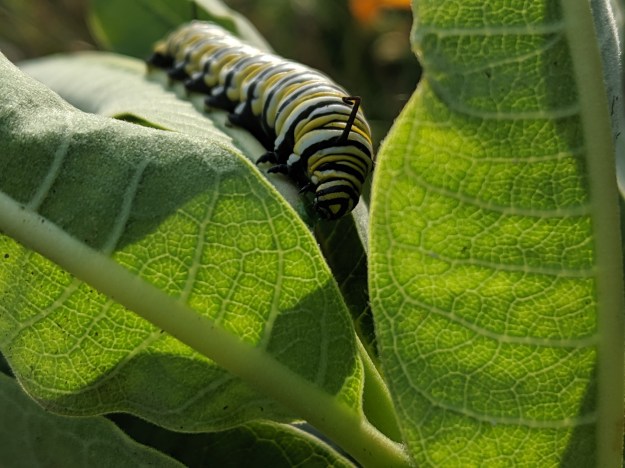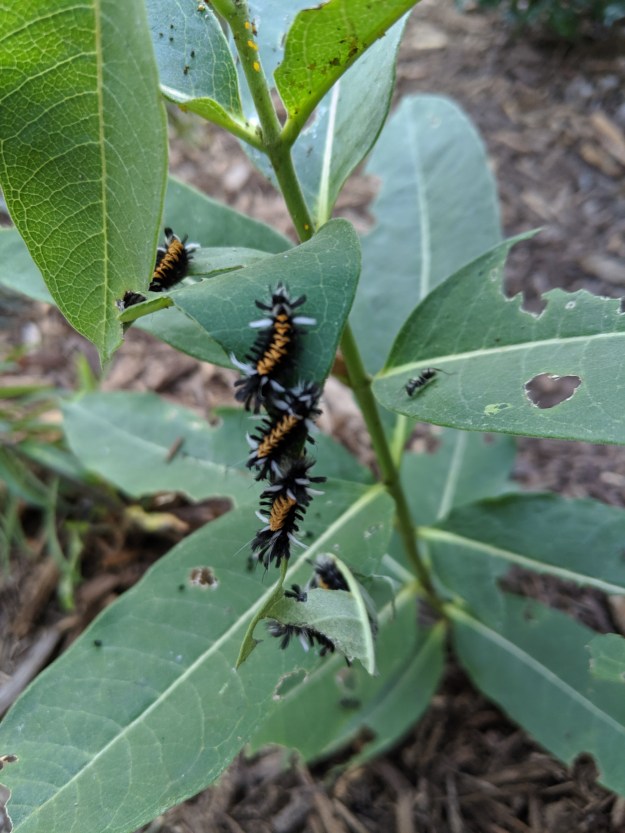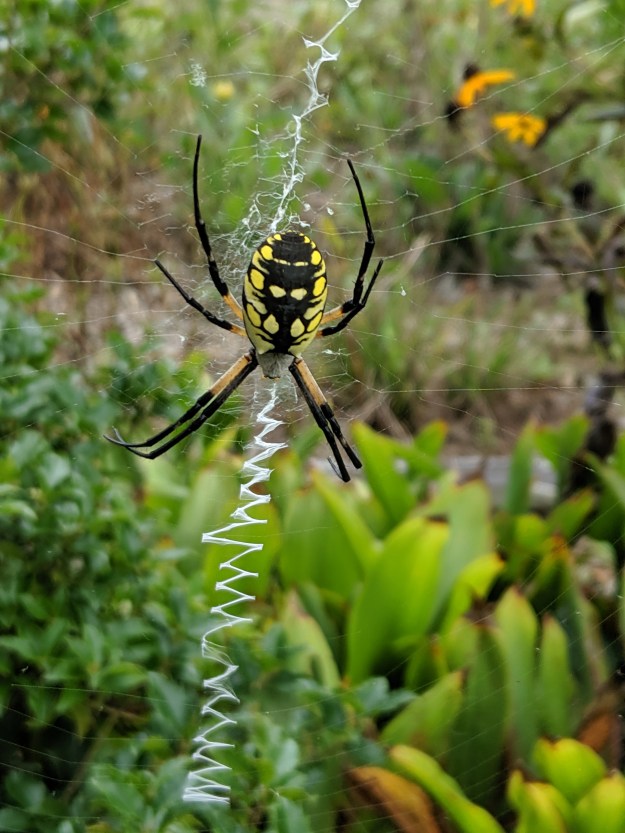Snow is covering the ground here, and the bees are all clustered around their respective queens keeping them warm for the winter. Just before the really cold weather hit, Doug installed quilt boxes and inserted winter patties into each hive. Quilt boxes contain burlap and wood shavings that can absorb condensation. Moisture is a killer of bees in the winter. The bee cluster stays about 80 degrees F, and moisture can condense on the inner cover of the hive. The quilt box catches the condensation instead of letting it drip back onto the bees. Most of our bees have lots of stored honey, but the winter patties are an extra source of nutrition just in case they need it. Since the bees are all snuggled in for the winter, I decided to write about what I have been doing to transform my flower garden into a monarch waystation.
Most people know monarch butterflies by their distinctive orange and black pattern.

This monarch is resting on the remains of a zinnia bloom.
In the fall, these amazing insects migrate to California and Mexico where they spend the winter. Monarchs only live 6-8 months, so the butterflies that flew south in the fall are not the same butterflies making the trip back into the US. You may already know that the monarch butterflies are in serious trouble. Their numbers have been declining rapidly due to loss of habitat, loss of nectar sources, and the declining amount of milkweed. Mature monarchs can feed on nectar from a variety of flowers, but they will only lay their eggs on milkweed plants. The larvae will only eat milkweed plants, and these plants are in short supply these days. Milkweed is the type of plant that grows wild along fence lines, in meadows, and in pastures. This wildflower was nearly everywhere in rural America years ago, so the monarchs had an abundant supply to use for laying their eggs. As more land becomes cultivated for agriculture and developed for housing and industry, the number of milkweed plants began to decline dramatically.

The tall green plants with the broad leaves are common milkweed. The top of each plant usually has a purple bloom in late summer.
This year I began making an intentional effort to convert my garden into a monarch waystation. If you want to try this yourself, you can read how here. The general idea is that you should plant at least 10 different milkweed plants of at least two different varieties. I planted butterfly weed and common milkweed. Both are varieties that are native to this part of Kentucky and are usually found as weeds along roadsides or in meadows, that is if you can find any undeveloped land. (I live in Boone County, KY which is one of the fastest growing areas in the state. Development may be good for people, but it is usually bad for pollinators.)

Butterfly weed growing in my garden.
If you are thinking of incorporating milkweed into your garden, you need to order your milkweed seed now. Milkweed seeds need to go through a cold period before they are planted. You can plant the seeds in pots and leave them outside through winter, or you can just buy your seeds now and put them in the crisper drawer of your refrigerator until spring. My plants didn’t do very well until their second year of growth. The effort paid off, and I was rewarded by finding a monarch caterpillar in my garden this fall.

Every day I would walk through the garden looking for my monarch caterpillar.
Some people watch television for entertainment. I stood in my garden for long periods of time just watching my caterpillar eat. You cannot believe how much these things eat and how quickly they can eat all the milkweed in your garden. My caterpillar was running out of milkweed fast, so on a Sunday afternoon I convinced Doug to go along with me to dig up milkweed from a field we own and transplant it into our garden so my caterpillar would not run out of food. My caterpillar was competing against the larva of the milkweed tussock moths, which also have enormous appetites.

Larva of the milkweed tussock moth
I was not familiar with the milkweed tussock moth before I started this little project, so I did some research. In one article I read, a person asked if he should kill milkweed tussock moths in order to help the monarchs. This question made me laugh and then made me sad. Instead of killing a moth species, let’s try to create enough habitat so they all can live. After several days, I no longer could find my caterpillar in the garden. Based on it’s size, it was ready to go into a cocoon. I kept looking but couldn’t find a cocoon in the garden. Maybe it was just well concealed. I regularly checked the web of my yellow garden spider just to make sure my caterpillar hadn’t turned into a butterfly only to be trapped in a spider’s web.

This yellow garden spider made a home in the garden in later summer. I was worried that my monarch butterfly might get too close.
The garden was filled with lots of drama this year, and I am anxious to pick back up in spring. I am hoping to increase the number of milkweed plants and to continue to add nectar rich flowers that bloom in different periods of the growing season. Bees like milkweed too, so what is good for the monarchs is also good for the bees. Maybe you would like to consider creating a monarch waystation. Hopefully you had a chance to read my post about humorous encounters teaching kids about bees. (If you haven’t, you should. It was one my most popular posts.) I am sometimes asked to give scout leaders ideas about projects they can do with their kids that will help bees. I like to suggest the monarch waystation because it is good for bees and monarchs. Sometimes the world’s environmental problems can seem overwhelming that they make us feel powerless. This is a great way to take a very concrete action that can really make a difference in your corner of the world.

I will try again to build a monarch way station in our front yard. Last year’s effort wasn’t successful. Thanks for your post.
LikeLiked by 1 person
Thanks for your comment. My milkweed didn’t really start taking off until year two. Good luck. 😀
LikeLike
Pingback: Do This in Winter If You Want to Start Keeping Bees This Spring | Married with Bees
Pingback: MarriedWithBees UNLEASHED! | Married with Bees